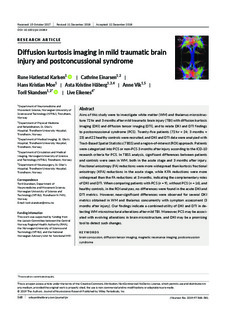| dc.contributor.author | Karlsen, Rune Hatlestad | |
| dc.contributor.author | Einarsen, Cathrine Elisabeth | |
| dc.contributor.author | Moe, Hans Kristian | |
| dc.contributor.author | Håberg, Asta | |
| dc.contributor.author | Vik, Anne | |
| dc.contributor.author | Skandsen, Toril | |
| dc.contributor.author | Eikenes, Live | |
| dc.date.accessioned | 2020-03-13T08:50:25Z | |
| dc.date.available | 2020-03-13T08:50:25Z | |
| dc.date.created | 2019-05-06T12:52:47Z | |
| dc.date.issued | 2019 | |
| dc.identifier.citation | Journal of Neuroscience Research. 2019, 97 (5), 568-581. | nb_NO |
| dc.identifier.issn | 0360-4012 | |
| dc.identifier.uri | http://hdl.handle.net/11250/2646659 | |
| dc.description.abstract | ims of this study were to investigate white matter (WM) and thalamus microstructure 72 hr and 3 months after mild traumatic brain injury (TBI) with diffusion kurtosis imaging (DKI) and diffusion tensor imaging (DTI), and to relate DKI and DTI findings to postconcussional syndrome (PCS). Twenty‐five patients (72 hr = 24; 3 months = 23) and 22 healthy controls were recruited, and DKI and DTI data were analyzed with Tract‐Based Spatial Statistics (TBSS) and a region‐of‐interest (ROI) approach. Patients were categorized into PCS or non‐PCS 3 months after injury according to the ICD‐10 research criteria for PCS. In TBSS analysis, significant differences between patients and controls were seen in WM, both in the acute stage and 3 months after injury. Fractional anisotropy (FA) reductions were more widespread than kurtosis fractional anisotropy (KFA) reductions in the acute stage, while KFA reductions were more widespread than the FA reductions at 3 months, indicating the complementary roles of DKI and DTI. When comparing patients with PCS (n = 9), without PCS (n = 16), and healthy controls, in the ROI analyses, no differences were found in the acute DKI and DTI metrics. However, near‐significant differences were observed for several DKI metrics obtained in WM and thalamus concurrently with symptom assessment (3 months after injury). Our findings indicate a combined utility of DKI and DTI in detecting WM microstructural alterations after mild TBI. Moreover, PCS may be associated with evolving alterations in brain microstructure, and DKI may be a promising tool to detect such changes. | nb_NO |
| dc.language.iso | eng | nb_NO |
| dc.publisher | Wiley | nb_NO |
| dc.rights | Attribution-NonCommercial-NoDerivatives 4.0 Internasjonal | * |
| dc.rights.uri | http://creativecommons.org/licenses/by-nc-nd/4.0/deed.no | * |
| dc.title | Diffusion kurtosis imaging in mild traumatic brain injury and postconcussional syndrome | nb_NO |
| dc.type | Journal article | nb_NO |
| dc.type | Peer reviewed | nb_NO |
| dc.description.version | publishedVersion | nb_NO |
| dc.source.pagenumber | 568-581 | nb_NO |
| dc.source.volume | 97 | nb_NO |
| dc.source.journal | Journal of Neuroscience Research | nb_NO |
| dc.source.issue | 5 | nb_NO |
| dc.identifier.doi | 10.1002/jnr.24383 | |
| dc.identifier.cristin | 1695778 | |
| dc.description.localcode | © 2019 The Authors. Journal of Neuroscience Research Published by Wiley Periodicals, Inc. This is an open access article under the terms of the Creative Commons Attribution‐NonCommercial‐NoDerivs License, which permits use and distribution in any medium, provided the original work is properly cited, the use is non‐commercial and no modifications or adaptations are made. | nb_NO |
| cristin.unitcode | 194,65,30,0 | |
| cristin.unitcode | 1920,5,0,0 | |
| cristin.unitcode | 194,65,25,0 | |
| cristin.unitcode | 1920,4,0,0 | |
| cristin.unitcode | 1920,16,0,0 | |
| cristin.unitname | Institutt for nevromedisin og bevegelsesvitenskap | |
| cristin.unitname | Klinikk for fysikalsk medisin og rehabilitering | |
| cristin.unitname | Institutt for sirkulasjon og bildediagnostikk | |
| cristin.unitname | Klinikk for bildediagnostikk | |
| cristin.unitname | Nevroklinikken | |
| cristin.ispublished | true | |
| cristin.fulltext | original | |
| cristin.qualitycode | 1 | |

